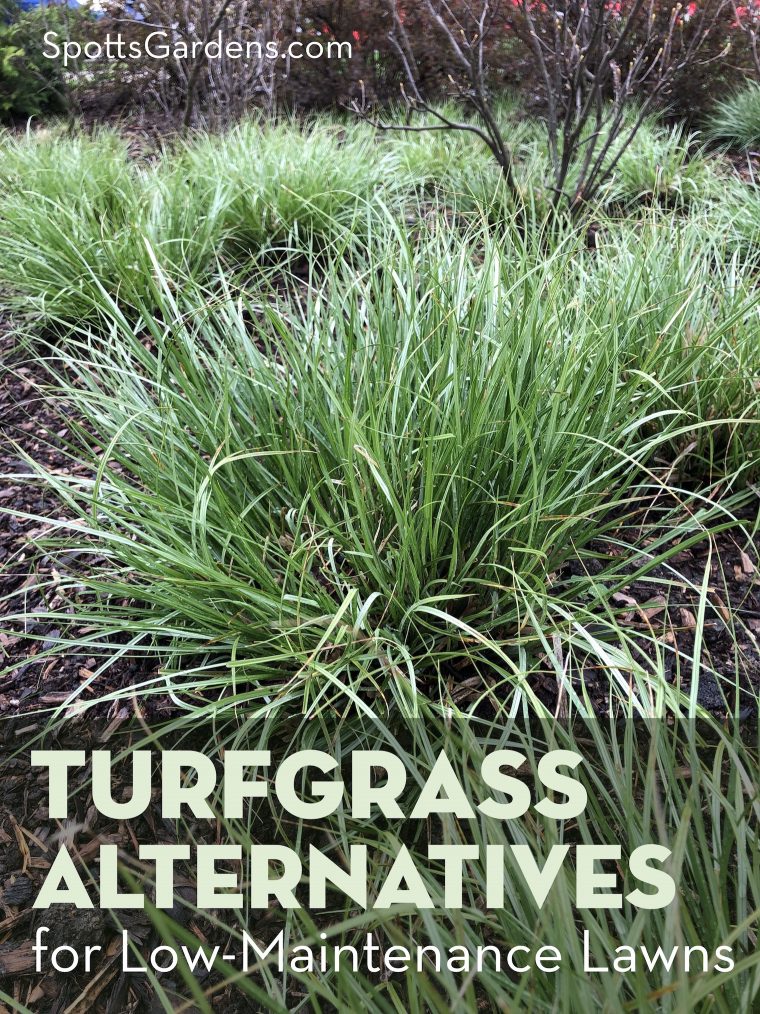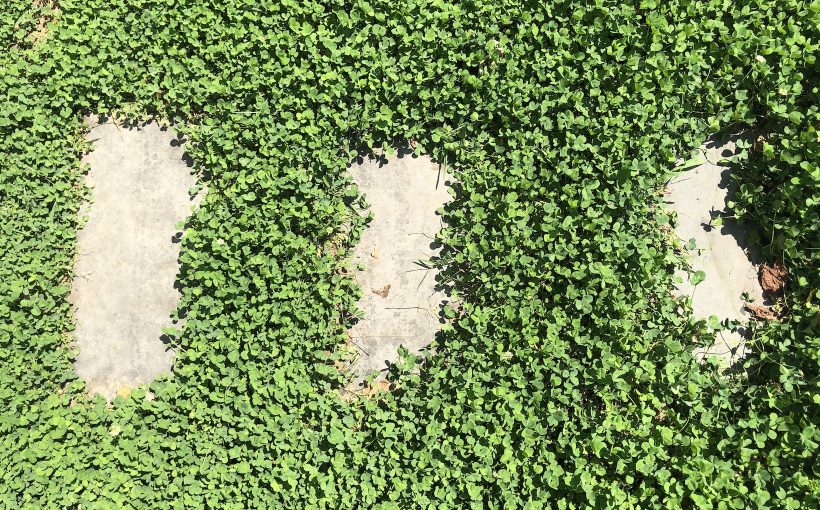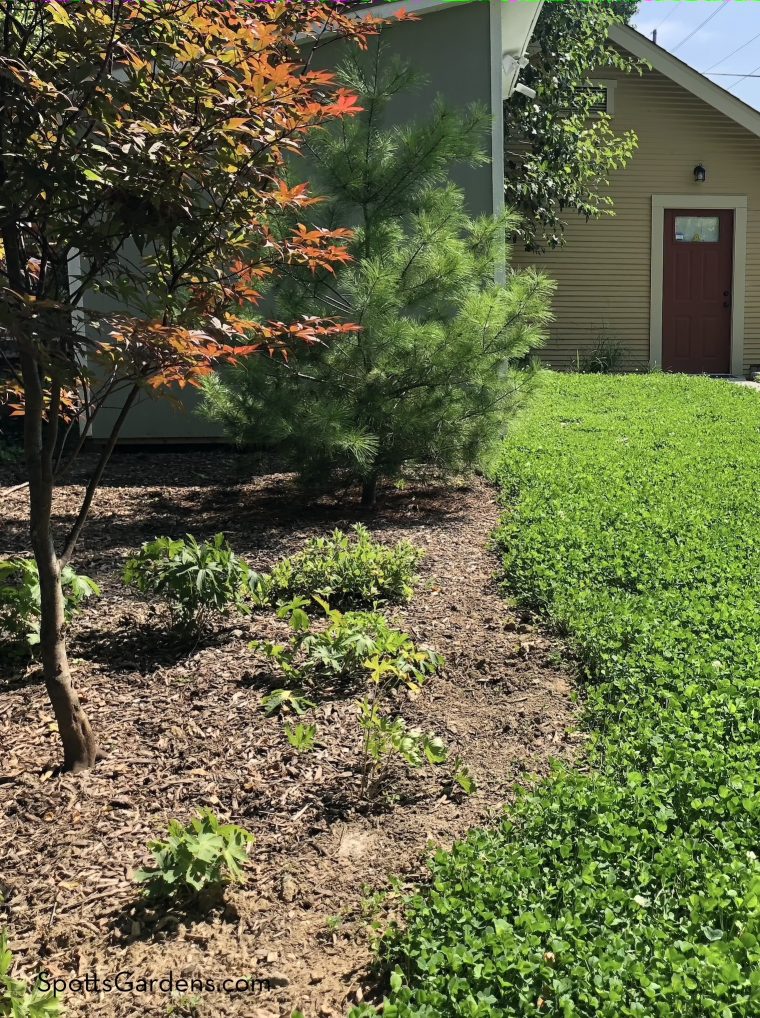If you’re not managing a golf course, there’s no earthly reason your lawn has to be a perfect swathe of green comprising one species of grass.
Rethink the lawn! Say goodbye to watering once a week, weeding and feeding, and spending your precious weekend pushing a lawn mower. Say hello to a space of close-cut green that looks pretty, supports bees and butterflies, and still leaves you room to play.

Choosing an Alternative to Turfgrass
Instead of thinking about what the lawn is “supposed to” look like, think about why you want it. In your garden, what purpose do you want your lawn to serve?
- A place for kids and dogs to play?
- Room for picnics and sunning?
- Space for your eye to rest among busy borders?
If you have lots of room devoted to lawn that is never walked on or played on, it might be time to replace that lawn with a more suitable groundcover. The right groundcover can increase biological diversity in your garden while reducing the need for maintenance. Check out some of our favorites here.
But let’s assume you need at least some lawn that can take foot traffic. Here are some great options.
Loosen Up Your Existing Lawn
Practice smart, organic lawn care. Raise your lawn mower deck to 3″ to encourage grass rather than weeds. Leave clippings on the lawn. Improve the soil. Water the lawn only when it starts to look stressed. If you do nothing but this, you can improve the health of your lawn while dramatically reducing your environmental impact.
Create a Mixed-Species Lawn
A lawn is just a space with close cut greenery, and there’s no rule that the greenery has to be a single species of grass. Allow broad-leafed “weeds” like clover, plantain, and violets into your lawn. Because all these plants are green, a pass with the lawnmower that knocks the flower heads off everything tidies the space quickly.
Yes, this look takes some getting used to, especially if you’ve been waging war on dandelions for years. But dandelions are an early food for pollinators, a bright splash of yellow in spring, and edible for humans. They bloom and seed in one big push in spring, then more or less subside to the occasional appearance the rest of the year. Maybe it’s time to make peace with them.
Use Miniclover
One of our favorite substitutes for turfgrass in the lawn is Miniclover from Outside Pride. This dwarf form of white clover (Trifolium reptans) only gets about 4″ to 6″ high. Like all clovers, it actually improves the soil by returning nitrogen to the ground. We’ve used it several ways:
- Include it in your existing lawn at about 2% to 5% coverage. The clover quickly fills in bare spots, muscling out weeds. Until the rise of the modern lawn-care industry, lawn mixes always included clover, which stays green and returns nitrogen to the soil.
- Use it alone as a clover lawn. In full sun to part sun, Miniclover works as a thick, effective lawn (shown in the photo above). It takes cutting well, so you can cut it down to whatever height you want. If you don’t want to mow at all, it will flower for about a month in summer, providing loads of food for bees.
- Use it as a cover crop to improve the soil before planting something else. In particularly rough spots, we use Miniclover as a temporary groundcover for a year. The following year, we till the clover in and rake the bed smooth before planting or sowing seed.
Plant Sedges
Grass-like sedges (Carex spp.) are a particularly good choice here in Indiana. Unlike our native ornamental grasses, which tend to be large and universally prefer full sun, native sedges are available in a range of heights and well adapted for shadier spots and nearly every moisture combination. Sedges are tolerant of black walnut trees as well.
Even the lowest-growing sedges will get at least 6″ to 12″ tall, which makes them taller than cut turfgrass. However, the ones we recommend here can be mown down to about 3″ or 4″ in height one to three times a year. Or if you prefer, just cut them back once in the spring to tidy them up, then let them grow the rest of the season.
- Lawn sedge (Carex leavenworthii) 6″ tall. Full sun to full shade; medium to dry soil; moderate foot traffic. Can be mown to 3″ to 4″ tall one to three times a year for a lawn. Note that while this sedge can take six hours of sun, it does not like hot sun. It will be fine in an east-facing garden with morning sun and afternoon shade, but should not be used in a south-facing or west-facing garden with intense afternoon light.
- Pennsylvania sedge (Carex pennsylvania): 16″ tall. Part sun to full shade; medium to dry soil; moderate foot traffic. Ideal for dry shade areas. Can be mown to 3″ to 4″ tall one to three times a year for a lawn.
- Texas sedge (Carex texensis): 6″ tall. Full sun to full shade; dry to moist soil; light foot traffic. Can be mown to 3″ to 4″ tall one to three times a year for a lawn. Use C. texensis in full sun only in the kind of conditions we discussed for C. leavenworthii. C. texensis does not tolerate intense afternoon light or hot sun.
Plant a Meadow
For more variety, you can create a meadow by interplanting your sedges with flowering annuals and perennials. For structure and weed control purposes, sedges and grasses should make up at least 50% of your meadow. We can help you choose the right plants for your conditions.
If you create a meadow, just cut everything down in the spring, rather than mowing repeatedly.
Ready to rethink your lawn?
We can help! Contact us for a free estimate.

